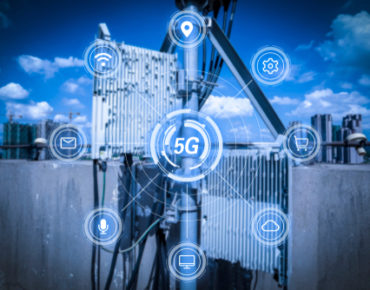5G Rollouts Predicated on Security, Coverage

via Shutterstock
The rollout of 5G networks is gaining momentum for use cases like digital health services as potential early deployers gauge the security, reliability and reach of the next-generation of wireless networks.
Signs of traction emerged with reports of talks between Verizon (NYSE: VZ) and Walmart (NYSE: WMT) to install 5G antennas and other gear to support the retailer’s digital health services. That use case is viewed as promising given the improved security—along with speed—of proposed 5G networks and the imperative to protect personal medical data.
Still, observers note that U.S. telecommunications equipment makers have yet to ramp up production of key 5G components like base stations.
Along with health care, other sectors expected to upgrade to 5G infrastructure include retailers, transportation, logistics and field services. Given the coverage limitations of 5G, retailers like Walmart could nevertheless leverage higher speeds and reduced latency for in-store applications ranging from filling prescriptions to inventory control.
While U.S. wireless carriers and their suppliers continue to trail 5G leaders like China’s Huawei, observers say potential customers are taking the first steps toward network infrastructure upgrades. According to a survey released in early March by SOTI, an Internet of Things and device management specialist, more than one-third of companies polled are working with 5G device manufacturers and mobile partners.
The enterprise mobility report also found that 37 percent of companies polled are implementing infrastructure upgrades with a heavy emphasis on mobile security. At the network edge, 29 percent of respondents said they are implementing mobile edge computing schemes to move processing horsepower closer to industrial and other IoT applications.
While 2020 is increasingly viewed as the year early adopters will jump on the 5G bandwagon, deployment plans have yet to transition to formal rollouts. The vendor survey revealed that just over half of companies it polled are unprepared for 5G deployments. Only 28 percent said they had their ducks in a row.
“If organizations are planning device refreshes this year, a key consideration will be to ensure visibility into, and security of, these devices with an integrated mobility and IoT management platform,” the 5G survey found.
Meanwhile, potential 5G adopters are sorting through competing claims by carriers about network performance and coverage, which tends to be faster but spotty. According to recent independent testing of download speeds on U.S. 5G networks, Verizon came out ahead of T-Mobile/Sprint and AT&T.
The testing service OpenSignal reported last month that Verizon’s 5G network delivered a download speed of 722.9 Mbps. Verizon and T-Mobile are for the first time using the new higher-frequency mmWave spectrum.
U.S. 5G rollouts have been held back by spectrum availability. OpenSignal noted that mmWave spectrum is extremely fast but best suited to applications like connectivity in a crowded sports stadium. Hence, so-called “low-band” 5G with extended coverage may be needed “for the creation of a diffused 5G coverage layer, with a limited uplift in terms of speed,” the tester said.
Carriers also are expected to introduce dynamic spectrum sharing approaches this year that combine 4G and 5G in the same spectrum band as a way of leveraging 4G coverage and 5G’s low latency.
Related
George Leopold has written about science and technology for more than 30 years, focusing on electronics and aerospace technology. He previously served as executive editor of Electronic Engineering Times. Leopold is the author of "Calculated Risk: The Supersonic Life and Times of Gus Grissom" (Purdue University Press, 2016).











